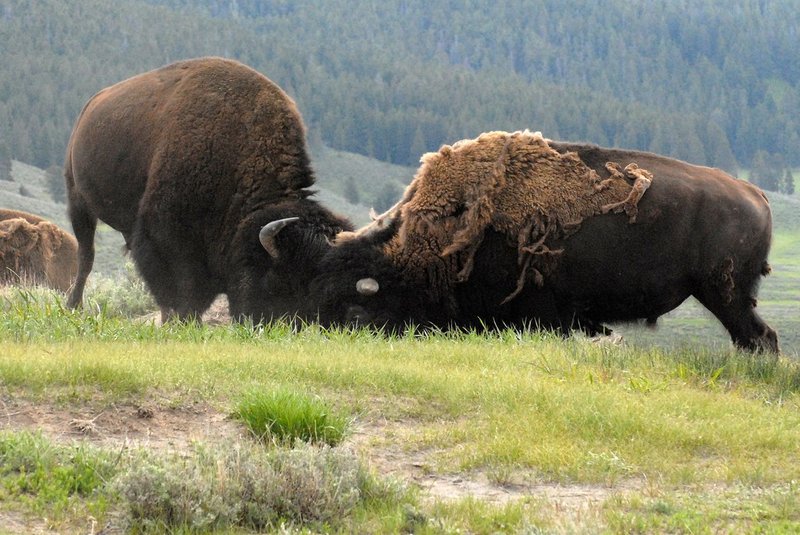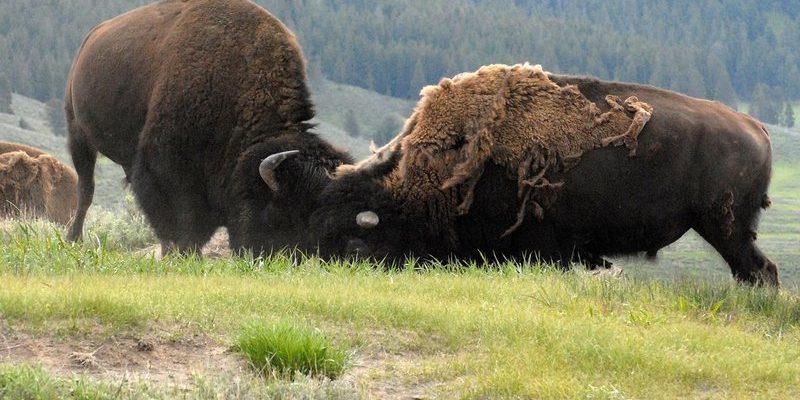
Imagine chatting over coffee about the fascinating ways bison interact within their herds, how they communicate, and how they navigate their environment. It’s not all about brute force; these animals display a range of behaviors that suggest a deeper level of thinking and social intelligence. Let’s explore the smart and surprisingly complex world of the American bison together.
The Social Structure of Bison Herds
Bison typically live in herds, which can range from a handful of individuals to hundreds. This social structure is not just about safety in numbers; it’s also a reflection of their intelligence. Within these herds, bison form strong bonds, exhibiting behaviors that suggest they understand relationships among other members.
Bison social structures are fascinating. Every herd has a leader, often an older female, who guides the group to food and water sources. This leader has likely learned through experience, showcasing a level of wisdom that benefits the entire herd. Bison communicate with one another through a series of grunts, snorts, and body language, indicating a level of emotional intelligence you might not expect from such large animals.
What’s interesting is that when danger approaches, bison often exhibit protective behavior. They’ll form a circle with the young and vulnerable in the middle. This instinctual behavior shows they not only recognize threats but understand the importance of cooperation for survival.
Learning and Memory: How Bison Navigate Their World
Cognitive abilities in animals often hinge on their ability to learn from their environment, and bison are no exception. Studies have shown that bison can remember locations of water sources and grazing areas, proving they possess an impressive memory.
Let’s think about how this works. Imagine if you had to remember where every good coffee shop is in your city, not just for yourself but for your friends as well. Bison do something similar; they can recall routes and landmarks that help them find food and shelter throughout the changing seasons. This ability also aids in their migration patterns, which can span vast distances, particularly during winter.
Bison also learn from each other. If one bison finds a food source, others may follow, indicating a shared knowledge within the group. This social learning showcases not just memory but an understanding of community dynamics, further highlighting their cognitive abilities.
Communication: How Bison Talk to Each Other
You might be wondering how bison communicate such complex ideas without words. Well, they certainly have their own unique ways! Bison use a combination of vocalizations, body language, and even smells to convey messages to one another.
Their vocalizations include various grunts and snorts, which can signal everything from contentment to distress. An interesting tidbit? Bison can even be heard “talking” to their calves, reinforcing social bonds and nurturing. Body language also plays a crucial role; a bison standing tall and swaying its head might be asserting dominance or signaling a warning.
Moreover, they use scents to convey information about their health and reproductive status. When bison rub against trees or grasses, they leave behind scent markings that communicate with others. This behavior is akin to how we might use social media to share updates about our lives!
Problem Solving: Bison and Their Environment
Bison are also capable of problem-solving, especially when it comes to their survival. They face numerous challenges in the wild, like finding food during harsh winters or escaping predators. Their ability to adapt to these challenges speaks volumes about their intelligence.
For instance, when searching for food in deep snow, bison use their massive heads to shovel through snowdrifts. This not only highlights their physical strength but also their determination and inventive thinking. They don’t just wander around aimlessly; they actively engage with their surroundings to overcome obstacles.
Here’s the thing: bison are not simply reacting to their environment—they are processing information and making decisions based on what they’ve learned from past experiences. This type of problem-solving is something we generally associate with more traditionally “intelligent” animals, like dolphins or primates.
The Impact of Human Activity on Bison Intelligence
Unfortunately, human activities have greatly impacted the lives of bison, from hunting to habitat destruction. These changes affect not only bison populations but also their behavior and cognitive abilities. When bison are pushed into smaller areas, their social structures and communication methods can become stressed.
With less space to roam, bison might struggle to find food and water, leading to competition among individuals. This can hinder their ability to form social bonds and learn from one another. It’s a reminder that intelligent creatures like bison are not just passive beings; they are deeply affected by the world around them.
Moreover, conservation efforts play a crucial role in helping bison maintain their natural behavior and cognitive functions. When bison are managed in ways that allow for their natural instincts to flourish, we see healthier herds that can exhibit their intelligence fully. Our understanding of bison intelligence is continually evolving, and protecting their habitats is vital for sustaining their social and cognitive abilities.
The Takeaway: Appreciating Bison Intelligence
So, how smart is the American bison? As we’ve explored, these magnificent creatures possess a surprising range of cognitive abilities and behaviors. Their social structures, communication methods, problem-solving skills, and adaptability are just a few of the aspects that highlight their intelligence.
Honestly, bison deserve more appreciation and respect than they often get. They are not just symbols of the American frontier; they’re intelligent animals that navigate their world with impressive skill and social wisdom. By understanding them better, we can foster a deeper respect for wildlife and the ecosystems they inhabit.
In a way, the American bison teaches us that intelligence is not just about brain size or problem-solving ability; it’s about connection, memory, and social relationships. Next time you think of bison, consider the rich inner lives they lead and the intricate ways they interact with each other and their environment. We have a lot to learn from these gentle giants.

